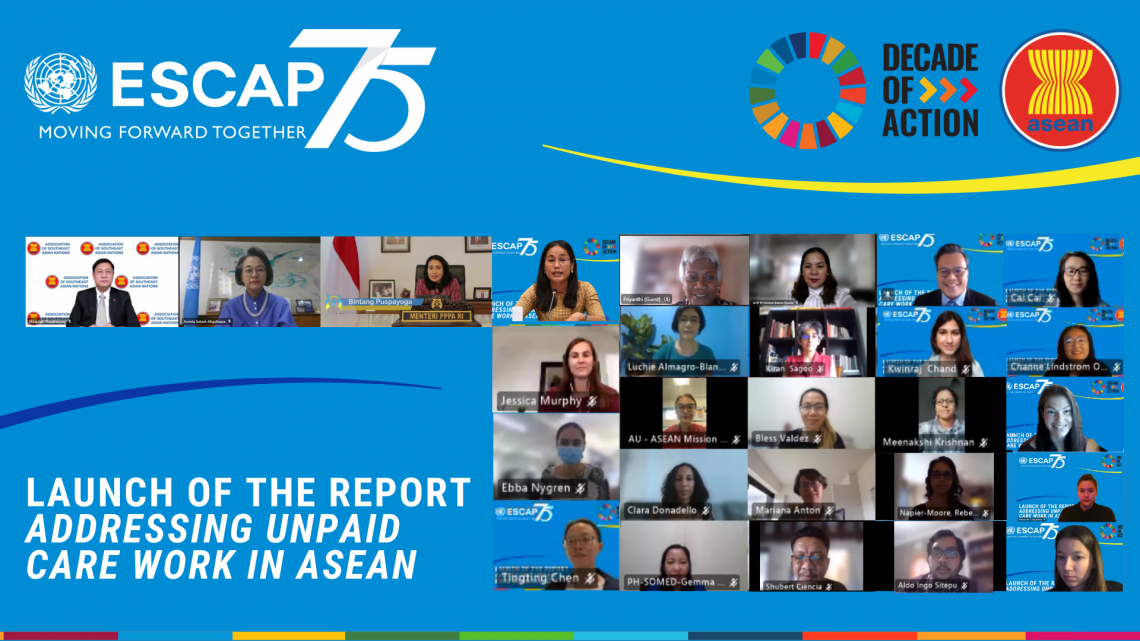|
BANGKOK, 14 October 2021 – If there is a silver lining to the ongoing COVID-19 pandemic, it may be that the critical role of women and girls as frontline health care workers and caregivers has finally come into the spotlight.
A new report released today by the United Nations Economic and Social Commission for Asia and the Pacific (ESCAP) and the Association of Southeast Asian Nations (ASEAN) reveals the gendered nature and unequal burden of care and domestic work in the region and the extent of vulnerabilities faced by women and girls that have been exacerbated during the pandemic. Even before the pandemic, women and girls performed more than four times as much unpaid care and domestic work as men and boys, for example, caring for home-schooled children, or sick or elderly family members. The Addressing Unpaid Care Work in ASEAN report finds that factoring the heavier burden and gender gap in unpaid care and domestic work that has greatly affected women’s ability to engage in labour markets and aggravated time poverty for women is a crucial step towards bolstering women’s economic empowerment in the region. “It is now time to turn our attention to policy solutions which reduce and redistribute unpaid care and domestic work. Investing in and building up care infrastructure can reduce the time spent on these daily subsistence tasks,” said Armida Salsiah Alisjahbana, Under-Secretary-General of the United Nations and Executive Secretary of ESCAP. She added that a mix of policies is needed to enable women and men to better reconcile the time requirements of the workplace with unpaid care work at home, including parental leave, care leave, care insurance schemes and flexible work arrangements, in order to improve women’s competitiveness and ensure women have equal opportunities in participating productively in the economy. Despite gaps in data, the report also highlights the situation for women in rural areas and women migrant workers, especially those engaged in care professions. Compared to their urban counterparts, these women face far more risks such as unequal access to care infrastructure and services, inadequate working conditions, precarious positions with low pay, and an acute absence of social protection. The COVID-19 pandemic has exacerbated these inequalities, therefore making women central to the pandemic recovery process. “ASEAN continues to leverage regional cooperation to address the root causes of unequal distribution of care and domestic work, these are deeply-entrenched gender norms and stereotypes that require collective action,” underscored Ekkaphab Phanthavong, Deputy Secretary-General of ASEAN for the ASEAN Socio-Cultural Community. While the gendered division of work and disproportionate care responsibilities are not new, addressing and tackling such matters at the policy level are considered pioneering among the countries of ASEAN. “The Report highlights promising policy measures that ASEAN Member States have undertaken prior to and during the pandemic to address women’s unpaid care work. It generates key recommendations to introduce a care-sensitive dimension into national and regional gender policies toward building back better and more equal,” said I Gusti Ayu Bintang Puspayoga, Minister for Women’s Empowerment and Child Protection of Indonesia. The report was launched on the sidelines of the Fourth ASEAN Ministerial Meeting on Women. It serves as a blueprint mapping the care economy in ASEAN countries as well as providing concrete policy actions across four domains of care infrastructure, care-related social protection, care services and employment-related policies. Read the full report: https://asean.org/book/addressing-unpaid-care-work-in-asean/ |
- ABOUT ASEANThe Association of Southeast Asian Nations, or ASEAN, was established on 8 August 1967 in Bangkok, Thailand, with the signing of the ASEAN Declaration (Bangkok Declaration) by the Founding Fathers of ASEAN: Indonesia, Malaysia, Philippines, Singapore and Thailand. Brunei Darussalam joined ASEAN on 7 January 1984, followed by Viet Nam on 28 July 1995, Lao PDR and Myanmar on 23 July 1997, and Cambodia on 30 April 1999, making up what is today the ten Member States of ASEAN.Menu
- WHAT WE DO
ASEAN organs always strive to achieve ASEAN’s goals and objectives, the Secretary-General of ASEAN and the ASEAN Secretariat shall be functioned as coordinating Secretariat to help facilitate effective decision-making withing and amongst ASEAN bodies. In addition, each Member State shall appoint a Permanent Representative to liaise with Secretary-General of ASEAN and the ASEAN Secretariat
Menu - WHO WE WORK WITH
ASEAN shall develop friendly relations and mutually beneficial dialogues, cooperation and partnerships with countries and sub-regional, regional and international organisations and institutions. This includes external partners, ASEAN entities, human rights bodies, non-ASEAN Member States Ambassadors to ASEAN, ASEAN committees in third countries and international organisations, as well as international / regional organisations.
Menu - OUR COMMUNITIES
The rodmap for an ASEAN Community (2009-2015) was declared by the leaders in 2009. The ASEAN Community, anchored on three community pillars: Political-Security Community, Economic Community, Socio-Cultural Community was launched in 2015. The ASEAN 2025: Forging Ahead Together was introduced in 2015 as a Post-2015 Vision. It comprises the ASEAN Community Vision 2025, the ASEAN Political-Security Community Blueprint 2025, the ASEAN Economic Community Blueprint 2025 and the ASEAN Socio-Cultural Community Blueprint 2025
Menu - SITEMAP





